A Cautionary Tale from My Multan Garden

I’m Ahmad Hassan. Five years into gardening, still learning, still messing up, but way better than when I started. I live in Multan—a city that bakes in summer and blooms in spring. My love affair with flowers began with roses, but calla lilies? They were different. Elegant. Mysterious. So, I planted a bunch. One day, while sipping chai in my garden, my cat Simba started chewing on a white calla. My heart dropped. I Googled frantically, “Are calla lilies poisonous to cats?” What I found? It shook me. That innocent bloom? Toxic. My flower friend was actually a silent threat.
The Shocking Truth about Calla Lilies and Cats
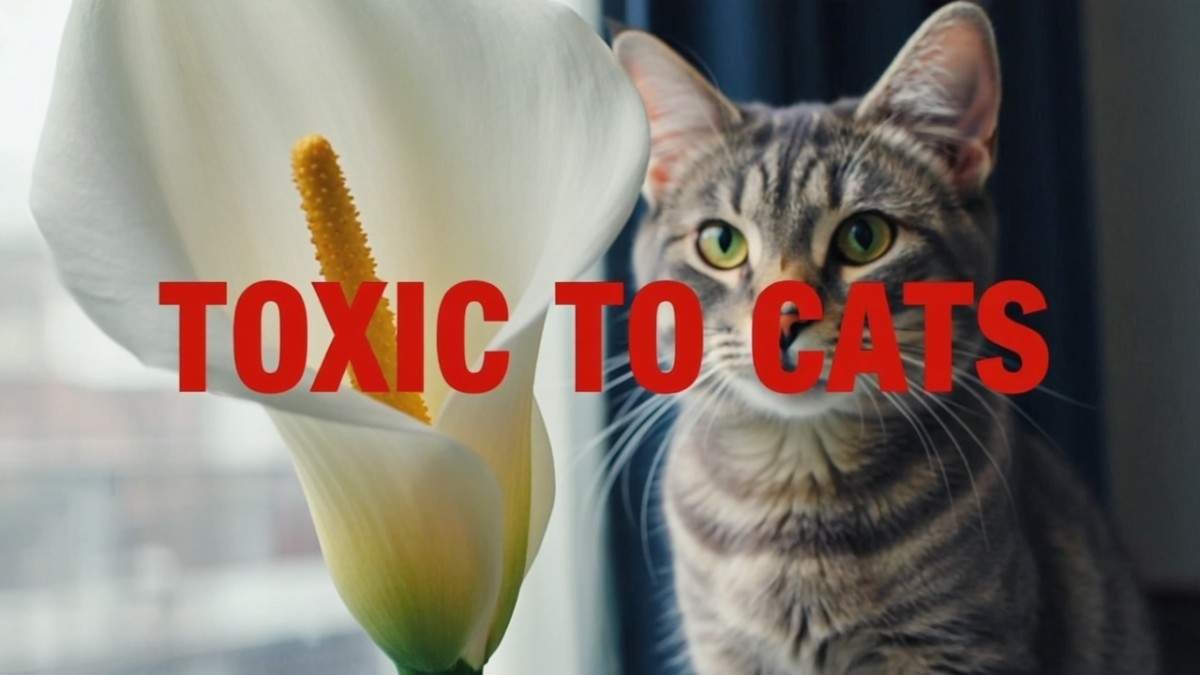
So, let’s answer the burning question right away—are calla lilies poisonous to cats? Sadly, yes. The beautiful, sleek, Instagram-worthy calla lily is dangerous for your feline friends. It contains insoluble calcium oxalates. Fancy name, scary result. When a cat bites the plant, these needle-like crystals shoot into their tissues—especially the mouth and throat. What follows is misery. Drooling, vomiting, and pawing at the face, refusing to eat. It’s not just a “meh, they’ll be fine” thing. It’s serious. As a cat parent, you need to act fast. Trust me—Simba barely forgave me.
But Wait… What Even Is a Calla Lily?
You’ve seen them. Long stem. Trumpet shape. Regal look. They come in white, pink, yellow—even black. And they’re popular in weddings, funerals, and Instagram reels. But calla lilies aren’t true lilies. Not even close. Botanically speaking, they belong to the Zantedeschia genus. Sounds like a spell, right? They originate from southern Africa but are now chilling in gardens worldwide. People love them because they’re elegant, low maintenance, and… poison-packed. Irony much? The real kicker is that most folks grow them without knowing their potential risk to pets. I was one of them.
Signs Your Cat Might Have Chewed a Calla Lily
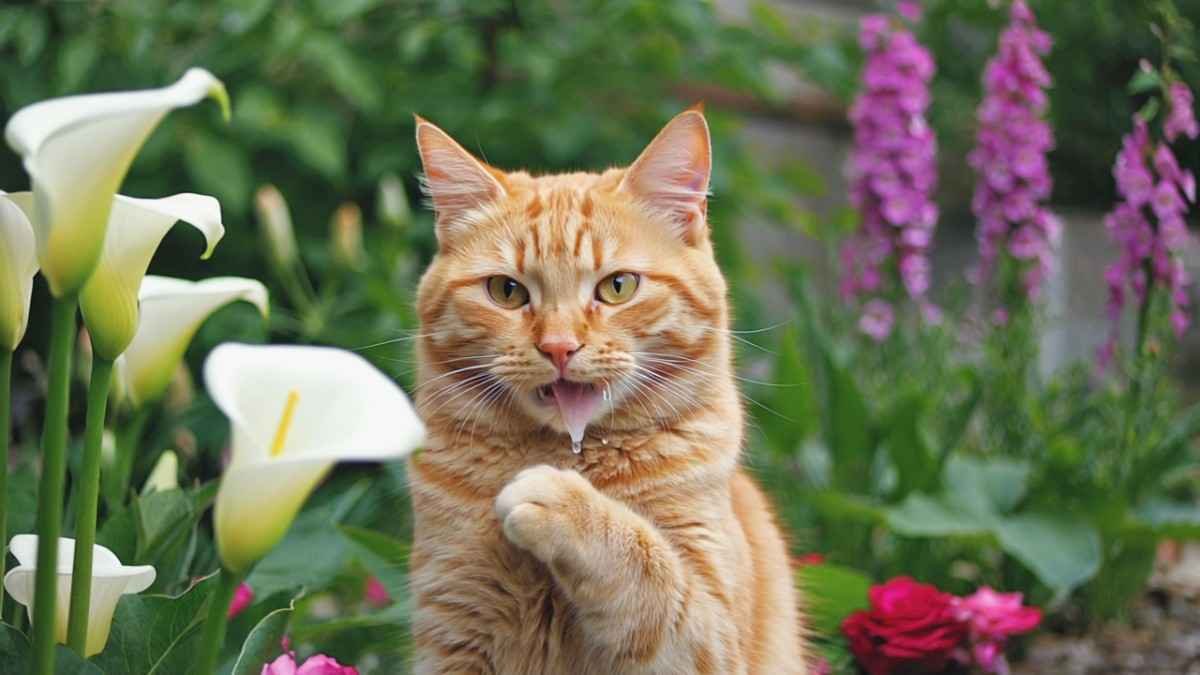
Let’s break it down. Your cat sneaks into the garden. Finds your gorgeous callas. Takes a bite. What happens next?
- Intense drooling
- Vomiting or dry heaving
- Difficulty swallowing
- Pawing at the mouth
- Loss of appetite
- Swelling of the lips, tongue, or throat
- Voice changes (meow sounds raspy)
- Lethargy or hiding
If any of these pop up, and you suspect calla contact, don’t wait. Call the vet immediately. I didn’t panic with Simba, but only because I acted within minutes. That made the difference.
What Makes Them So Toxic?
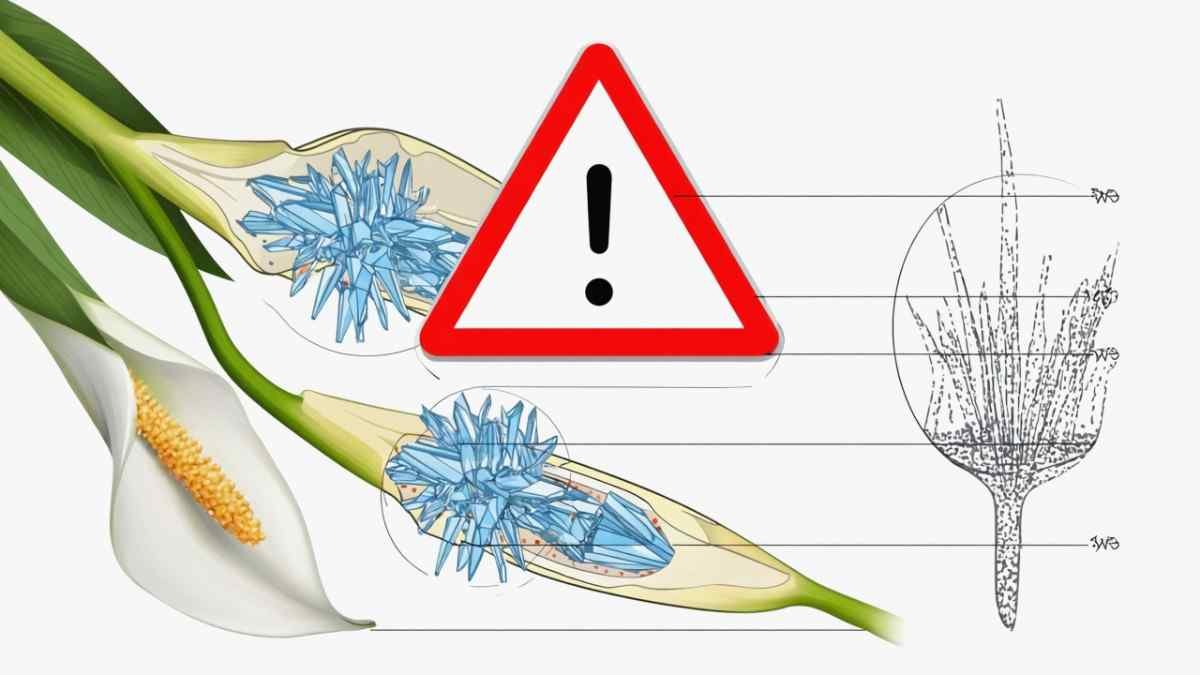
Okay, time to nerd out a little. When you ask, “Are calla lilies poisonous to cats,” the true enemy inside them is calcium oxalate crystals. Imagine microscopic needles. These sharp crystals embed themselves into your cat’s mouth and throat tissues. The result? Pain. Lots of it. Unlike true lilies (like Easter lilies), callas don’t cause kidney failure. That’s some relief. But the pain, swelling, and secondary complications? Still a nightmare. If your cat ingests a larger portion of the plant, it may lead to difficulty breathing or choking. Don’t roll the dice here. Better safe than sorry.
The Vet Visit – What to Expect (And Pay For)
So your cat munched a lily and now you’re speeding to the vet. Good. Here’s what likely next is:
- The vet will ask for details—what plant, how much, when.
- Your cat might need to be sedated if the swelling is severe.
- They’ll administer anti-inflammatory meds or antihistamines.
- Activated charcoal may be used to absorb toxins (if ingested).
- Pain relief, fluids, and monitoring come next.
Cost? Depends on where you are. In Multan, Simba’s treatment cost me around 6,000 PKR. In bigger cities or abroad, it can skyrocket. But money aside—your cat’s life is priceless.
How I Cat-Proofed My Garden (After the Panic)

Lesson learned, right? I wasn’t taking chances again. Here’s what I did:
- Relocated the lilies to a high pot stand. Decorative, unreachable.
- Put up fencing around sensitive flower beds. A bit ugly. But it worked.
- Planted cat-friendly greens like catnip, lemongrass, and mint. Gave Simba a safer snacking zone.
- Used motion-activated deterrents. Costly, but effective.
- Supervised garden time—no more solo missions for Simba.
Your garden should be a joy, not a hazard. With a little planning, it can be both pet-safe and flower-filled.
Why Cats Even Chew on Plants (its Not Just Curiosity)
Ever wondered why your adorable menace chooses leaves over kibble? Turns out, cats chew plants for a bunch of reasons:
- Curiosity
- Boredom
- Texture (they enjoy the crunch)
- Upset stomachs (they instinctively seek out greens)
- Lack of nutrients
- Playfulness
But here’s the catch—they can’t tell the safe from the deadly. A rose petal and a toxic lily? All the same to them. That’s why the responsibility falls on us. You can’t train cats like dogs. You cat-proof instead.
Are All Lilies Poisonous to Cats?

Great question. Short answer—almost all are.
Here’s a quick lily danger scale for cats:
- Extremely toxic: Easter lily, tiger lily, Asiatic lily, daylily – causes kidney failure
- Moderately toxic: Calla lily, peace lily – causes oral irritation
- Mildly toxic or non-toxic: Peruvian lily – may cause upset stomach
So yes, calla lilies are poisonous to cats, but thankfully, they don’t usually cause death. Still… it’s pain, stress, and vet bills. Why risk it?
What If My Cat Just Sniffed the Lily?
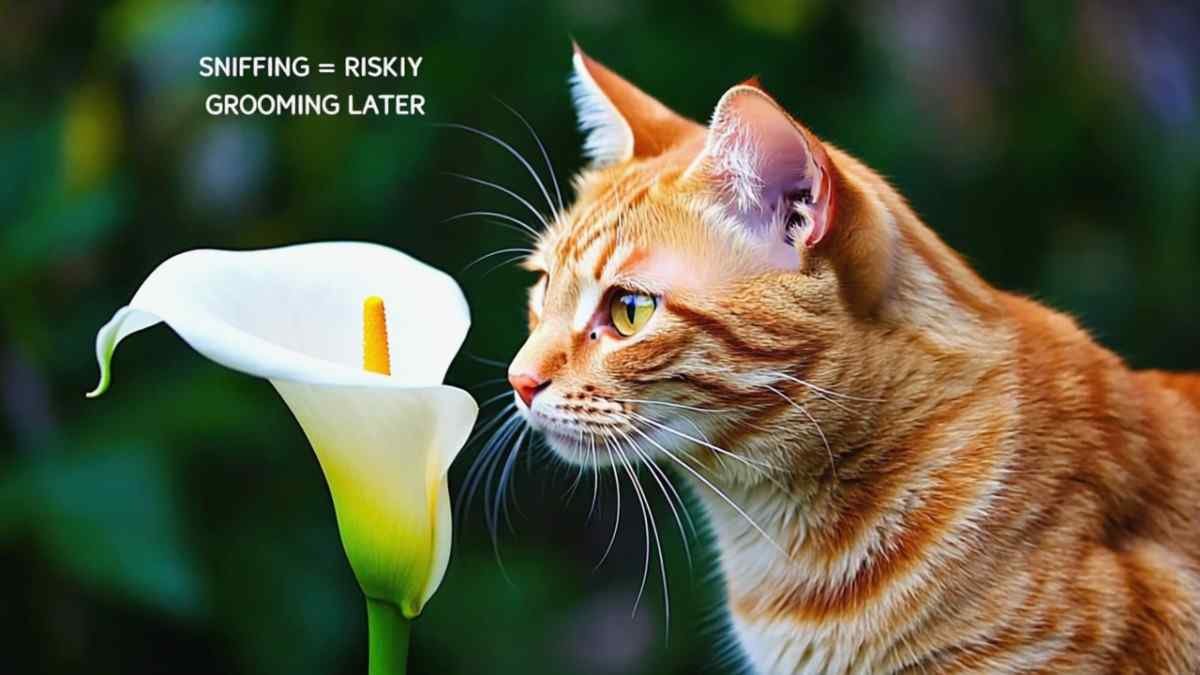
Breathe easy. Sniffing is generally safe. Cats aren’t in danger unless they chew or ingest the plant. Still, some cats get pollen on their fur. And guess what? They groom it off later. That means even pollen can lead to ingestion. So if your cat got too close, wipe down their fur with a damp cloth just in case. Always better to prevent than to panic.
Solutions, Safer Alternatives & Stories You’ll Remember
So, after the great Simba scare, I turned my garden into a cat-safe haven. But the more I read and spoke to vets, the more I realized how little people know. Everyone’s heard about lilies being toxic. But calla lilies? People think they’re too elegant to be deadly. Sorry, beauty. That trumpet bloom hides a sharp surprise. The big question still lingers in many cat owners’ minds—are calla lilies poisonous to cats if they’re white, pink, or purple? Let’s unravel the rest, one pet-safe paragraph at a time.
Are White Calla Lilies Poisonous to Cats?
Oh yes. White ones, pink ones, black ones—it doesn’t matter. Toxic is toxic. White calla lilies might look more innocent, but they still carry those nasty calcium oxalate crystals. These sharp crystals don’t discriminate by color. So don’t be fooled by aesthetics. Even if you see “pure white wedding bouquet” vibes, it’s still bad news for your curious fur ball. If your cat munches a white calla, the symptoms and treatment will be the same as with any other color. So always treat all callas as a no-go zone for pets.
The Plants I Switched To (Cat-Friendly Beauties)
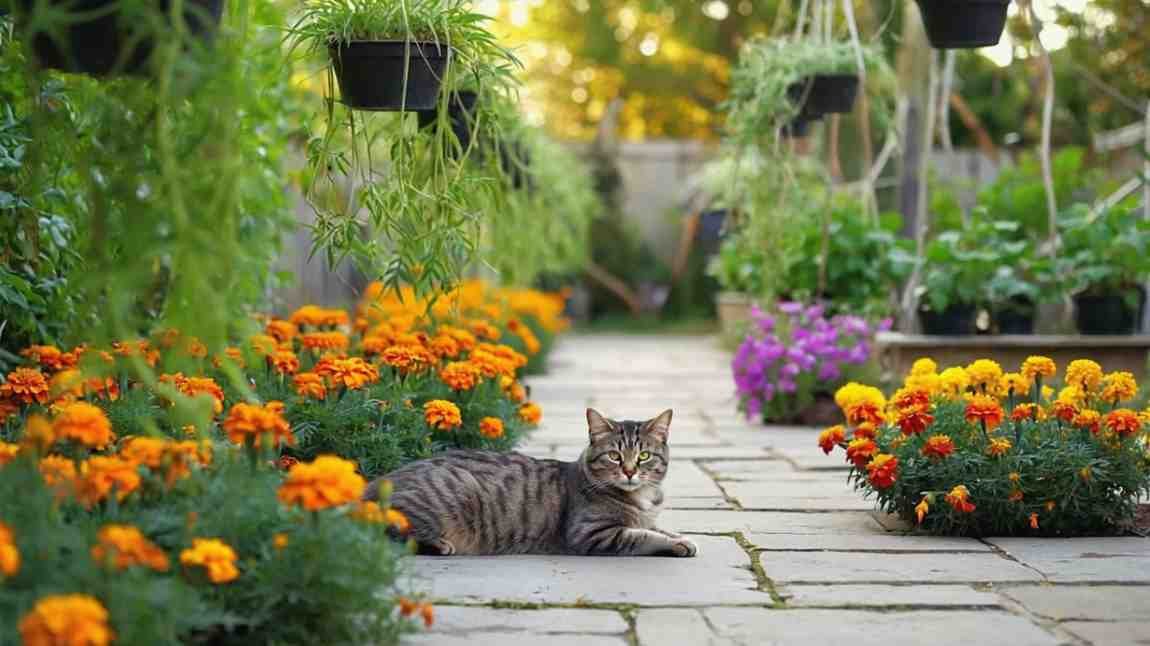
After that unforgettable vet trip, I pulled out half my garden. Yeah, it hurt. But it had to be done. I replaced calla lilies with these safer options that still keep my garden gorgeous:
- Spider Plants – Super easy to grow and cats love batting at the leaves.
- Areca Palm – Looks tropical, zero toxicity.
- Marigolds – Bright, pest-repelling, and safe.
- Snapdragons – Tall, colorful, and kitty-approved.
- Cat Grass – Cats adore it. Bonus: it helps with digestion.
- Basil and Mint – Safe herbs that keep both your cat and kitchen happy.
Swap toxic with trust. That’s my new motto.
Let’s Talk Indoor Lilies Too (Because Accidents Happen Indoors)

It’s not just your backyard that’s a battleground. Indoor decor also matters. I once saw a friend casually place a vase of lilies on the living room table. Her cat was already sniffing. I didn’t want to be dramatic but… yeah, I was dramatic. “Get that out now!” I said. Moral of the story? Even cut flowers are dangerous. Cats chew petals, leaves, and even drink the vase water. And yes—calla lily water is toxic too. So if you’re gifted a bouquet with callas, admire it, snap a photo, then keep it away. High shelf or garbage bin. No in-betweens.
What If I Really Want to Keep Calla Lilies?
Fair. They’re beautiful. I get it. I miss mine too sometimes. So if you absolutely can’t part ways with them, here are some compromise strategies:
- Hang them in baskets far out of paw reach.
- Use a greenhouse cabinet with closed glass doors.
- Only display during special events when your cat is safely in another room.
- Train your cat with bitter sprays, though not foolproof.
- Keep callas in outdoor-only zones that your cat can’t access.
It’s doable. But it takes effort. And constant vigilance. Just remember, one bite can lead to hours at the vet.
A Real Message from a Fellow Cat Parent (And Now, Friend)
A reader from Lahore, Amina, emailed me after Part 1. Her story? She had no idea lilies were toxic. One day, she found her Persian cat, Fluffy, drooling beside a vase of white callas. She panicked. Rushed to the vet. Turns out, it wasn’t life-threatening, but it cost her Rest? 12,000 and a week of Fluffy refusing to purr. She ended her message with: “I wish I knew this sooner. Your blog saved me the second time.”
That message? Made my week. And reminded me—this isn’t just gardening. This is real stuff that affects lives.
How to Cat-Proof You’re Garden in Simple Steps
If you’re like me, you want flowers and felines. So here’s a no-fluff action plan:
- Step 1: Identify all toxic plants (use a pet-safe app or printable checklist).
- Step 2: Relocate or remove high-risk ones like callas and true lilies.
- Step 3: Use raised beds and planters with barriers.
- Step 4: Supervise outdoor time—no solo garden exploration.
- Step 5: Provide distraction plants like catnip, oat grass, or wheatgrass.
- Step 6: Educate your guests and neighbors. That “friendly plant gift” could be poison.
- Step 7: Watch your cat after any yard play—look for chewing behavior.
Final Thoughts: The Real Cost of a Single Bloom
Calla lilies are stunning. They glow in the moonlight, sway in the wind, and charm every visitor. But as a cat parent, I’ve learned to love with limits. Ask yourself—is it worth the risk? That moment of “aesthetic” could lead to emergency rooms, panic, and lifelong guilt. I’d rather have Simba purring at my feet than lilies blooming in my bed. That’s not drama. That’s just love in its most responsible form.
So next time someone asks you, “Are calla lilies poisonous to cats?”—don’t just say yes. Tell them why. Share the story. Save a life.
FAQs: Quick Answers to Common Questions

-
How poisonous are calla lilies to cats?
Calla lilies are moderately toxic. They won’t cause kidney failure like true lilies but lead to severe oral pain, drooling, vomiting, and discomfort.
-
Are white calla lilies poisonous to cats?
Yes. All colors of calla lilies contain the same calcium oxalates, making white calla lilies just as dangerous as any other shade.
-
What should I do if my cat ate a calla lily?
Call your vet immediately. Even if symptoms seem mild, it’s best to act fast. Treatment may include pain relief, fluids, and anti-inflammatory medication.
-
Can cats die from eating calla lilies?
Death is rare from calla lilies alone, but severe swelling can lead to complications like choking. Immediate treatment prevents worst-case outcomes.
-
What flowers are safe for cats?
Try marigolds, snapdragons, roses (petals only), orchids, and catnip. Always double-check before planting or gifting flowers to cat owners.
-
What part of the calla lily is toxic to cats?
All parts—the leaves, stem, and flower—contain insoluble calcium oxalate crystals. Even a nibble can trigger symptoms.
-
Can calla lilies harm dogs too?
Yes, dogs can also react to calla lilies with mouth irritation, vomiting, and difficulty swallowing. Keep lilies away from all pets.
-
How long does it take for symptoms to show?
Usually within minutes. The mouth irritation is immediate. Watch closely for the first few hours after suspected ingestion.
-
Is calla lily water toxic to cats?
Yes. The water from a vase of callas can leach toxic substances. If your cat drinks it, it may get sick. Always dispose of flower water properly.
-
Should I remove all calla lilies from my home?
If you own a cat, yes. Unless you can 100% guarantee no contact, it’s safest to avoid them entirely.
Thanks for sticking with me till the end.
I hope this helped you laugh a little, worry a little less, and protect your cat a whole lot more. If you’ve got a story or question, I’m always listening over at homegardeni.com/contact-us.
Stay safe, stay blooming—but maybe without the callas.
— Ahmad Hassan, from Multan, with love and a little cat hair on my shirt
RELATED POSTS :
If you need more knowledge about calla lily flowers so these links are helpful for you :
https://homegardeni.com/calla-lily-the-bold-beautiful-bloom-with-a-heart/
https://homegardeni.com/calla-lily-colors-a-rainbow-of-elegance-in-your-garden/
https://homegardeni.com/the-purple-calla-lily-plant-elegance-dash-drama/
https://homegardeni.com/calla-lily-and-rose-bouquet-a-love-story-in-petals/
https://homegardeni.com/black-calla-lilies-mysterious-beauty-in-bloom/